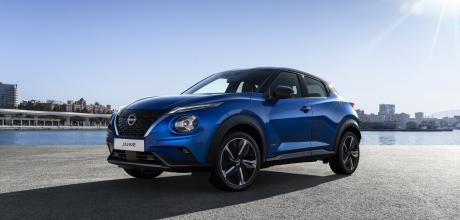2023 Nissan Juke gains all new Hybrid variant
Following the launch of the Qashqai in 2021 and the arrival of the Ariya and new X-Trail this summer, Nissan is bolstering its electrified line-up with the addition of a new hybrid version of the Juke at a similar time.
Sharing its drivetrain with its sister car, the Renault Captur, it is built on the CMF-B platform. Lift the bonnet and you’ll find a 93bhp 1,598cc petrol engine, together with a 48bhp electric motor, making a combined power output of 141bhp. The powerplant itself develops 109lb ft of torque, as well as a 151lb ft contribution from the electric motor. While still subject to final homologation, Nissan is quoting economy figures of 54mpg and CO2 emissions of 118g/km.
The 1.2kWh battery is water cooled, there’s a 15kW (20bhp) high voltage starter and generator and a clutchless motor modial gearbox that employs dog clutches instead of the more normal synchroniser rings to shift the four internal combustion engine and two electric gears. The ‘box matches the shifts no matter whether operating in pure electric, petrol or a combination of the two. The result is a 25% improvement in power compared to the Juke’s current petrol engine, along with a 40% improvement in fuel economy on the urban cycle and a 20% reduction on the combined cycle.
The Juke Hybrid is designed to always start up in its pure electric mode, with the capacity to travel at speeds of up to 34mph before the petrol engine will kick in. When slowing down, the electric motor will operate as a generator and capture any kinetic energy, converting it into electricity so that it can be stored in the hybrid propulsion battery. A choice of three driving modes – Eco/Normal/Sport alters the aggression level of the brake regeneration system. As with the Leaf, Nissan has fitted the handy e-pedal system to the Juke Hybrid so that drivers can control the vehicle with a single pedal – the accelerator.
The launch of the Juke Hybrid coincides with some improvements to the vehicle, with the new Nissan logo emblazoned on the revised front mesh grille, together with Hybrid badges on the front doors and tailgate. Alterations to the airflow result in a revised bumper, including automatically adjustable radiator grille shutter that adjusts airflow, reducing aerodynamic drag as much as possible. At the rear of the car, the spoiler has been reprofiled, there’s a cover over the rear axle and tyre spoilers ahead of the front wheels have been reshaped and repositioned to enhance aerodynamics. Completing the fresh exterior look are new duotone 17-inch alloy wheels, together with Ariyaderived 19-inch aero wheels that are particularly eye-catching.
To accommodate the 1.2kWh battery pack and hybrid paraphernalia, it means a smaller boot compared to its petrol sister car, with a reduction of 68 litres. This results in a size of 354 litres with the seats up and 1,237 litres with them folded down. Arriving in showrooms this summer, prices are expected fromw around the £25k mark, with the upper trim levels of Acenta, N-Connecta, Tekna and Tekna Plus predicted to be on offer.


